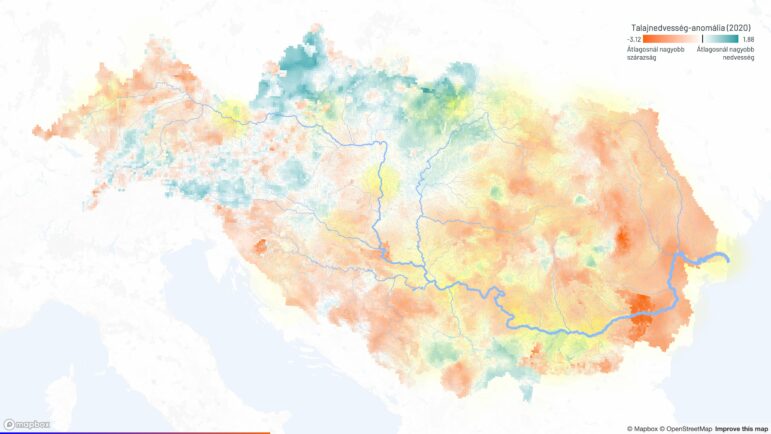

The Australia Broadcast Corporation dug into the data for each position on the pitch and compiled a list of 32 stars to watch at the 2023 FIFA Women's World Cup. Image: Screenshot, ABC
Data Journalism Top 10: A Scorched Earth, Hot French Baby Names, and Women’s World Cup Stars to Watch
Read this article in
This week, ZEIT Online used data and maps to illustrate a “climate crisis in time lapse” — a portrait of the earth’s maximum temperatures on July 15, one of the hottest days in an already record-breaking hot month. Our Top 10 in Data Journalism round-up also highlights shifts in global demographics, as covered by both Al Jazeera and The New York Times; NGL.media’s look at property holdings of the Moscow-affiliated Orthodox Church in Ukraine; Le Monde’s look at France’s most popular baby names; and ABC’s deep analysis of data to predict which players you should watch as the FIFA Women’s World Cup kicks off.
Scorched Earth
During a week (and month) of broken heat records around the world, ZEIT Online used publicly available datasets from the NCEP Global Forecast System and the University of Maine’s ClimateReanalyzer.org to produce a snapshot of the world’s maximum temperatures on July 15, 2023 — visualized on an interactive globe. They call attention to some areas of notable extremes — southern Europe, North Africa, parts of China, the US’s “heat dome” — but readers can also click on any country to see how it fared on July 15. See also some other ideas on how to visualize the effects of the climate crisis.
As the World Ages
Major demographic shifts are underway across the globe, and New York Times visual journalist Lauren Leatherby dug into the world’s oldest and youngest countries to illustrate what it all means. As high-income nations shrink, with rapidly aging populations, there is a “demographic sweet spot” opening up for lower-income nations who will have huge working-age populations for the first time. This enormous opportunity can also backfire, however, if there aren’t enough jobs for young people. Meanwhile, wealthier countries need reforms to keep pensions — and the quality of life they take for granted — sustainable. For World Population Day, Al Jazeera also crunched some data to show what the world’s population might look like in 2050 — when there will be around 9.7 billion of us.
Russian Military Casualty Count
Though many news outlets have attempted to make an accurate count, figures for Russian military casualties since its invasion of Ukraine in February 2022 are challenging to confirm. A joint investigation — and the first independent statistical analysis — by Meduza, Mediazona, and Tübingen University statistician Dmitry Kobak puts the “true” number of Russian KIAs at roughly 47,000, an astonishing number. By analyzing existing reports on published obituaries, mortality data from the Federal State Statistics Service, and extensive records from the National Probate Registry to assess “excess mortality” — a concept popularized during the COVID-19 pandemic — they estimate that between 40,000 and 55,000 Russian men under the age of 50 died fighting in Ukraine by May 27, 2023. For context, this figure is roughly three times greater than all the soldiers killed during Russia’s decade-long war in Afghanistan. Read this tweet thread on methodology.
Dying Dialects
Canapé, summer bird, lard: some unique Swiss German vocabulary words might soon be extinct. Switzerland has one of the world’s most colorful dialect landscapes, notes Marc Brupbacher of the daily Tagesanzeiger, with even some neighboring villages using different words for everyday items. Brupbacher and Mathias Lutz team dug into the shifting spread and prevalence of common words in German-speaking parts of Switzerland from 1940 to 2020 — but also used these patterns to forecast which ones might disappear by 2060 and 2100.
Women’s World Cup Breakout Stars
Success in soccer games can come down to a matter of millimeters; the margin between being a good player and an extraordinary one can be just as small. The Australia Broadcasting Corporation’s digital story innovation team looked deep into position skill sets and individual player data for the 2023 FIFA Women’s World Cup, co-hosted by Australia and New Zealand, to find stand-out players to watch during the tournament. In particular, ABC looked for up-and-coming stars that aren’t already household names — to uncover what makes them better than their peers.
Forever Chemicals
In the southern US state of South Carolina, an industrial by-product from factories and sewage plants called sludge is used to fertilize the fields. Although rich in certain nutrients and cheaper than traditional fertilizer, there are concerns that the “forever chemicals” it contains could be contaminating rivers, streams, and drinking water supplies. This investigation by The State newspaper and McClatchy used data from the state health department and local drinking water utilities to investigate the problem. Reporters found more than 3,500 agricultural fields have been approved for sludge disposal, identifying and mapping areas where there is a high concentration of sludge sites near drinking water sources with elevated levels of these long-lasting chemicals.
Russian Orthodox Land Ownership in Ukraine
Since Russia’s invasion, there have been moves to limit the influence of the Moscow-affiliated Orthodox Church in Ukraine. Some congregations have swapped their affiliations, while some Ukrainian politicians have moved to ban the Russian-aligned religious organization in certain regions and cities. For this project, nonprofit outlet NGL.media and partner organization YouControl parsed Ukrainian state registers to create the first real estate database of holdings by those congregations still affiliated with the Moscow Patriarchate. The 2,876 buildings and 3,798 land holdings they found were plotted on a dynamic interactive map: hover over any particular marker and you can see the address, named owner, and size of the plot.
Pretrial Detention in Paraguay
Pretrial detention is an issue in Paraguay, where two-thirds of prisoners are kept behind bars even though they have yet to be sentenced, the highest rate in South America. InSight Crime’s Christopher Newton used data from the Institute for Crime & Justice Policy Research at the University of London, the National Police, and Paraguay’s Ministry of Justice to dig into crime and pre-sentencing detention figures. Graphs reveal overcrowding in the country’s key penitentiaries (which could be fueling organized crime), the percentage of inmates that are convicted or in pretrial detention in different jails, and how many prisons are operating at overcapacity (all but two). Read the story in English and in Spanish.
What’s in a (French Baby) Name?
From Léa to Nathalie, Celine to Manon, as different names became chic in France, their popularity likewise surged among parents naming their children. For this piece, reporters at Le Monde used data from the National Institute of Statistics and Economic Studies (Insee) to examine French baby name trends over time. Use the search box to check if your own name has ever been popular in France, and see maps of the most popular boys and girls names in each region throughout history. Data journalists noted a surge in the number of babies being named Elvis in the late 70s, and Cristiano in the early 2000s. Last month, the same team used national figures to create a graphic for readers to find out “how special” they are based on their birth date.
https://twitter.com/crookedfootball/status/1680836500441686016
Homeownership Trends in the UK
Writing in the Financial Times, data journalist John Burn-Murdoch explores “the yawning gap between those with and without parental wealth,” to show how home ownership in Britain has become a hereditary privilege. He uses government data and his own analysis of the UK’s Wealth and Assets survey to show how a growing number of people are living in a property partly paid for or gifted entirely by their parents, and to reveal how the volume of those getting parental contributions for a deposit is soaring. Homeownership, he finds, is lower among those whose parents were not homeowners, a fact that stays true even when the young adults in question are high earners.
Bonus Game: Sickly Sweet
To end on a sugar high, try this interactive from the Washington Post, which has designed a creative interactive for readers to try and pinpoint what’s in their food. The upshot? Lots of the artificial sweeteners added to sugar-free foods are hard to spot. (Acesulfame potassium, anyone?)
 Laura Dixon is an associate editor at GIJN and a freelance journalist from the UK. She has reported from Colombia, the US, and Mexico, and her work has been published by The Times, The Washington Post, and The Atlantic. She has received fellowships from the IWMF and the Pulitzer Center.
Laura Dixon is an associate editor at GIJN and a freelance journalist from the UK. She has reported from Colombia, the US, and Mexico, and her work has been published by The Times, The Washington Post, and The Atlantic. She has received fellowships from the IWMF and the Pulitzer Center.
 Alexa van Sickle is an associate editor at GIJN. She was previously a senior editor for the foreign correspondence magazine Roads and Kingdoms. She has also been an editor at the International Institute for Strategic Studies and a publisher at an international law non-profit in London. She lives in Vienna, Austria.
Alexa van Sickle is an associate editor at GIJN. She was previously a senior editor for the foreign correspondence magazine Roads and Kingdoms. She has also been an editor at the International Institute for Strategic Studies and a publisher at an international law non-profit in London. She lives in Vienna, Austria.









